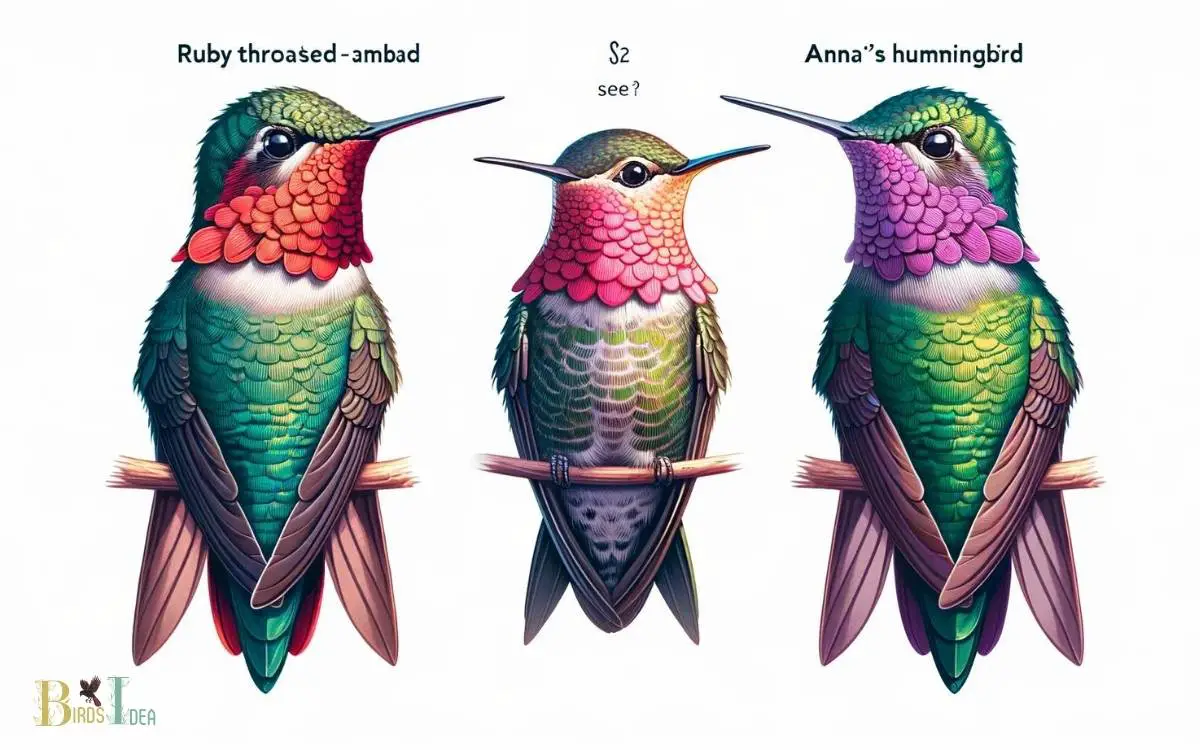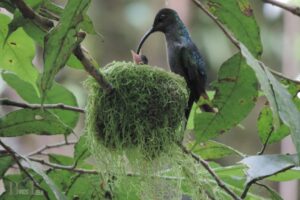Difference Between Ruby Throated and Anna’s Hummingbird
The Ruby-throated Hummingbird and Anna’s Hummingbird are two distinct species with notable differences in appearance, range, and behavior.
The Ruby-throated Hummingbird (Archilochus colubris) is known for its iridescent ruby-red throat in males and is predominantly found in the eastern part of North America.
In contrast, Anna’s Hummingbird (Calypte anna) displays a shimmering rose-pink throat in males and a green back and is commonly spotted in the western part of the continent, particularly along the Pacific Coast.
Ruby-throated Hummingbirds and Anna’s Hummingbirds exhibit different physical characteristics that aid in their identification.
For instance, the male Ruby-throated Hummingbird boasts a brilliant red throat, which the females lack.
They are relatively small and have a more extensive migratory pattern, traveling as far as Central America during the winter months.
On the other hand, Anna’s Hummingbirds present a vibrant pink throat in males, which extends over the head, and females have a more muted coloration.
Anna’s Hummingbirds are larger, and many do not migrate, staying within their range year-round.
Here are some key points that distinguish them:
Identifying Ruby-throated and Anna’s Hummingbirds involves observing their throat coloration, with the former sporting a striking ruby-red

Key Takeaway
Physical Characteristics
The physical characteristics of the Ruby Throated and Anna’s hummingbird can be distinguished by their size, coloration, and specific markings.
The Ruby Throated hummingbird is approximately 3-3.5 inches in length, with a metallic green back and a vibrant ruby-red throat patch on males, while females have a white throat and greenish back.
Conversely, Anna’s hummingbird is slightly larger, measuring 3.9-4.3 inches, with a metallic green crown and back, and males display a brilliant rose-red crown and throat.
Both species have iridescent feathers, but the Ruby Throated hummingbird’s throat patch is a distinguishing feature, while Anna’s hummingbird’s larger size and prominent rose-red crown set it apart.
These distinct physical characteristics facilitate easy differentiation between the two species.
Feeding Behavior
Feeding behavior in Ruby Throated and Anna’s hummingbirds is characterized by their ability to hover while sipping nectar from flowers.
Despite their similarities, there are distinct differences in their feeding behaviors:
- Diet: Ruby Throated hummingbirds primarily feed on nectar from brightly colored, tubular flowers. In contrast, Anna’s hummingbirds have a more diverse diet, including nectar as well as small insects and spiders.
- Territoriality: Ruby Throated hummingbirds are highly territorial and fiercely defend their feeding areas. Anna’s hummingbirds are also territorial but are more likely to share feeding spaces, especially in winter.
- Feeding Patterns: Ruby Throated hummingbirds are known for their consistent feeding patterns, visiting specific flowers at regular intervals. Anna’s hummingbirds have more varied feeding patterns, often visiting a wide range of flowers in a less predictable manner.
- Migration: Ruby Throated hummingbirds migrate long distances, while Anna’s hummingbirds are non-migratory or undertake shorter migrations.
Distribution and Habitat
Distribution and habitat preferences differ between Ruby Throated and Anna’s hummingbirds.
Ruby Throated hummingbirds are found predominantly in Eastern North America, from southern Canada to the Gulf of Mexico, while Anna’s hummingbirds are native to the western coast of North America, from southern Alaska to Baja California in Mexico.
In terms of habitat, Ruby Throated hummingbirds prefer woodland edges, gardens, and areas with abundant flowers, while Anna’s hummingbirds are commonly found in open woodland, scrubland, and urban and suburban gardens.
The following table provides a concise comparison of the distribution and habitat preferences of the two hummingbird species:
| Aspect | Ruby Throated Hummingbird | Anna’s Hummingbird |
|---|---|---|
| Distribution | Eastern North America | Western coast of North America |
| Habitat Preference | Woodland edges, gardens | Open woodland, scrubland, gardens |
Mating and Reproduction
During mating and reproduction, both Ruby Throated and Anna’s hummingbirds engage in distinctive courtship behaviors to attract mates. These behaviors are essential for successful reproduction and the continuation of their species.
Here are some key differences in the mating and reproductive behaviors of these two hummingbird species:
- Mating Displays: Ruby Throated hummingbirds perform an impressive aerial display, while Anna’s hummingbirds showcase their vibrant iridescent feathers during their courtship rituals.
- Nesting: Ruby Throated hummingbirds build their nests using plant fibers and spider silk, while Anna’s hummingbirds construct their nests with plant down and lichen, providing a subtle distinction in their nesting materials.
- Incubation: Female Ruby Throated hummingbirds solely incubate their eggs, whereas Anna’s hummingbird males occasionally assist in incubation.
- Brood Size: Ruby Throated hummingbirds typically have smaller brood sizes, usually consisting of 1-3 eggs, while Anna’s hummingbirds may have slightly larger broods, often with 2-4 eggs.
The mating and reproductive behaviors of these hummingbird species reveal intriguing distinctions in their courtship, nesting, and parental care strategies.
This knowledge offers valuable insights into the unique ecological adaptations of these birds. As we delve into their migration patterns, it becomes evident how these behaviors also influence their seasonal movements.
Migration Patterns
In examining the difference between Ruby Throated and Anna’s hummingbirds, it is crucial to consider their distinct migration patterns.
Ruby Throated hummingbirds are known for their remarkable migration journey. They travel alone and often cover around 500 miles non-stop across the Gulf of Mexico to reach their wintering grounds in Central America.
In contrast, Anna’s hummingbirds are non-migratory in some regions, such as along the Pacific Coast of North America, where the climate is mild year-round.
However, populations at higher latitudes, like those found in the Pacific Northwest, may exhibit some migratory behavior, moving to warmer areas during the winter.
Understanding these differing migration patterns provides valuable insight into the ecological and environmental adaptations of these unique hummingbird species.
Conclusion
The ruby-throated and Anna’s hummingbirds exhibit distinct physical characteristics, feeding behaviors, distribution and habitat preferences, mating and reproduction patterns, and migration habits.
These differences contribute to their unique ecological niches and roles within their respective environments.
Overall, the two species exemplify the diverse and fascinating world of hummingbirds, each with its own distinctive traits and behaviors that make them both remarkable and essential members of their ecosystems.






